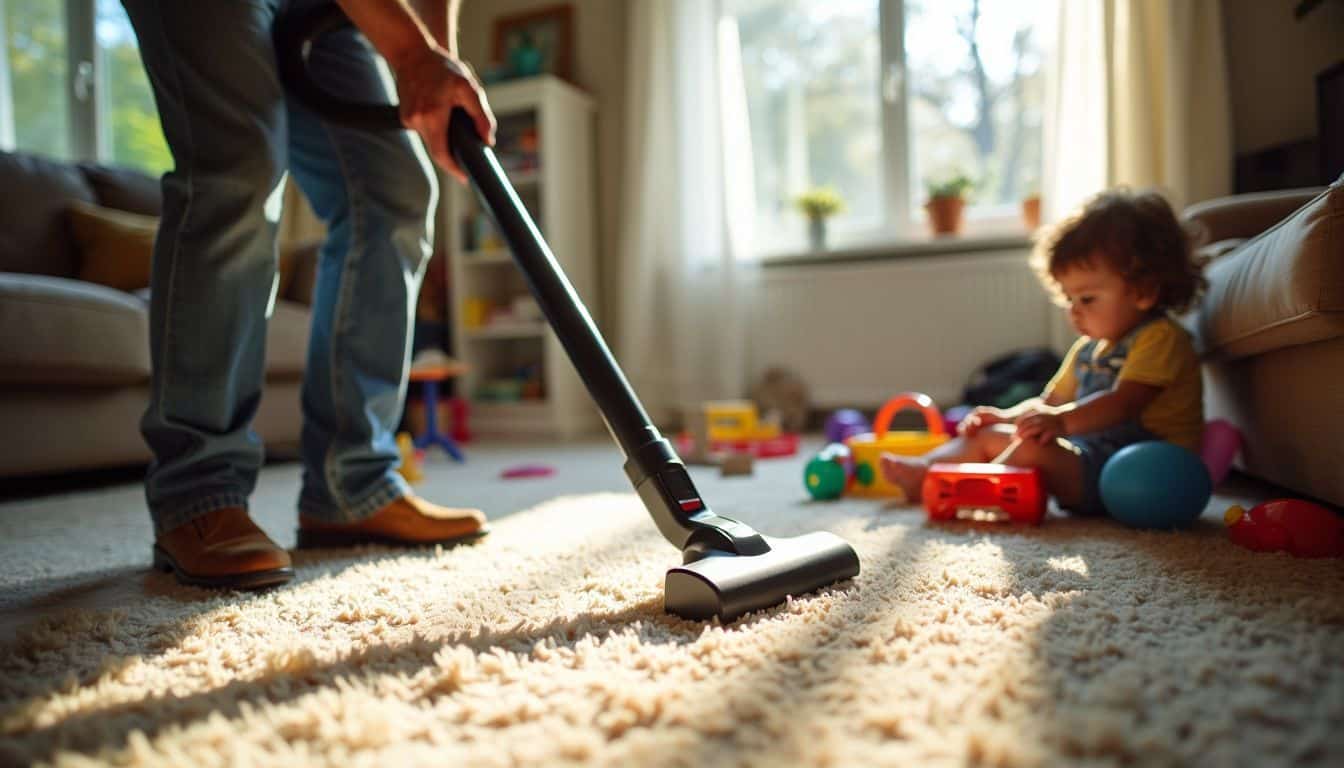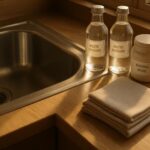Everyone wants a healthy home. But sometimes, sneezing, coughing, and itchy eyes make that hard. The problem? Allergens like dust mites, pet fur, and mold are hiding in your house. Removing allergens is key to feeling better. And nothing better than always maintaining your house clean.
Did you know? About 80% of people breathe in dust mite waste. It can make allergies and asthma worse. This post will show you how to clean your home of these tiny invaders for fresher air and fewer allergy symptoms. Get ready for tips on vacuum cleaners with HEPA filters, air purifiers, and keeping your indoor environment clean.
Keep reading for relief.
Key Takeaways
- About 80% of homes in the U.S. have dust mites, and 60% have problems with pet fur.
- Using air purifiers with CERTIFIED asthma & allergy friendly® filters can catch nearly 98% of allergens.
- Vacuuming floors and carpets once or twice a week with a HEPA filter vacuum helps stop allergies.
- Washing bedding every week in hot water kills dust mites.
- Installing exhaust fans in kitchens and bathrooms reduces moisture and mold growth.
Understanding Allergens in the Home

Allergens in the home can make life tough. These unwanted guests, like dust mites, pet fur, and cockroach bits, are mostly found where we feel safest. About 80% of homes in the U.S. have dust mites.
Also, 60% deal with cat or dog fur issues. Urban areas or places in the southern U.S. see more problems with cockroaches.
These allergens hide in pets, carpets that cover whole rooms, soft chairs and sofas, toys filled with stuffing, bed sheets and pillows that you can’t wash easily, damp spots around your house; also indoor plants can keep allergen levels high if they trap mold spores too.
It’s important to know what causes bad air inside our homes because this knowledge is the first step toward making our living spaces safer for those with asthma or allergies and anyone wanting cleaner air to breathe.
Steps to Control Indoor Allergens

To start removing allergens indoors, start with a clean house. Use air purifiers and look for products with the asthma & allergy friendly® mark to help keep your home safe.
Regular Cleaning Routines

Removing allergens is a big deal for parents. A clean home means healthy kids and fewer allergies. Here’s how to do it:
- Vacuum floors and carpets once or twice a week. Make sure your vacuum cleaner has a HEPA filter. This catches tiny particles that cause allergies.
- Dust surfaces often. Use damp cloths to pick up dust instead of spreading it around.
- Wash all bedding every week. Use hot water, at least 130°F, and dry them on high heat to kill dust mites.
- Put special covers on pillows and mattresses. These covers block dust mites.
- Keep your home dry to stop mold from growing. Use dehumidifiers in damp areas like basements.
- Clean filters in your air conditioners and heaters regularly to keep the air clean.
- Open windows often for fresh air, but close them during allergy season to keep pollen out.
- Avoid using strong cleaning products that have harsh chemicals or smells.
- Take off shoes at the door or use a doormat to reduce dirt coming in.
- If you have pets, bathe and groom them regularly to reduce pet dander in the house.
- After cleaning, leave the house for a few hours if possible, especially if you wear a mask while cleaning to avoid breathing in any stirred-up allergens.
Following these steps can help keep your indoor air quality high and reduce allergens in your home, making it healthier for everyone living there.
Use of Air Cleaners

Air cleaners are a big help in making homes healthier, especially for families. They can reduce allergens that cause asthma and allergies. Here’s how:
- Look for air cleaners with CERTIFIED asthma & allergy friendly® filters. They capture nearly 98% of allergen bits.
- Make sure the air cleaner removes at least 75% of stuff floating in the air to get certification.
- Use air purifiers in rooms where you spend most time, like bedrooms and living rooms. They drop pollen, mold bits, dust-mite stuff, and pet dander.
- Pick air cleaners that showed a big drop in tiny harmful particles. A study found a 51.8% decrease in PM2.5 (tiny bad particles) after six weeks of use in bedrooms.
- Place air purifiers away from walls and furniture for best airflow.
- Clean or replace filters as advised to keep the machine working right.
- Choose machines that match your room size for effective cleaning.
- Air purifiers with HEPA (High-Efficiency Particulate Air) filters are great against tiny nasties in the air.
- Avoid purifiers that make ozone, which can harm lungs and make breathing problems worse.
10 Clean the pre-filters regularly to boost performance and extend filter life.
Using these steps will help keep your home’s air clean and reduce health risks linked to indoor pollutants and allergens, providing a safer environment for your family to breathe easier.
CERTIFIED Asthma & Allergy Friendly® Products

CERTIFIED Asthma & Allergy Friendly® products must pass strict tests. These tests check if they make indoor air better. The Asthma and Allergy Foundation of America (AAFA) helps with this.
They look at how vacuum cleaners keep dust in and take allergens out. They also see if cleaning supplies let out bad chemicals or smells.
Air purifiers that have this certification need to clean the air well without adding problems. Products like these lower risks from things like house dust, pet dander, and pollen inside homes.
This means fewer allergy attacks at home. Parents who choose these items make a healthier place for their families to live and breathe by removing allergens.
Room-by-Room Guide to Reducing Allergens

Check out our room-by-room guide for tips on keeping your home free from allergens. We cover every area – the place you sleep, the spot you relax, where you cook, and even where you bathe.
You’ll learn how to handle things like air purifiers in bedrooms, choosing the right cleaning tools for living areas, managing moisture in kitchens to prevent mold growth, and ensuring bathrooms are well-ventilated to avoid dampness.
Ready to make each part of your house safer? Keep reading!
Bedroom

The bedroom is a key battleground against allergens. Studies have found that over 99% of bedrooms in the U.S. carry at least one type of allergen, with about 74.2% housing three to six types.
To fight back, using dust-mite-proof covers on pillows and mattresses is a smart move. Washing bedding weekly at temperatures above 130°F (or 54°C) helps kill off dust mites too.
Since pets can bring in more allergens, they should stay out of the bedroom. Bathing pets weekly cuts down on what they might bring in.
Choosing synthetic materials for bedding and opting for low-pile carpets or skipping carpets altogether can also make a big difference in keeping the air clean. Next up: tackling the living room to create an even healthier home environment.
Living Room

Moving from the bedroom to the living room, it’s key to keep this area free of allergens too by removing allergens. Hard floors like wood or linoleum are better than carpets that can hold dust and other triggers.
It’s wise to replace chairs with cushions for ones without upholstery. These choices make cleaning easier and reduce places for allergens to hide.
For cleaner air, keep windows shut during pollen season. This prevents outdoor allergens from coming in. Air conditioning helps too, by filtering the air inside your home. Don’t forget about plants—while they add beauty, their soil can grow mold.
Covering soil with aquarium gravel solves this problem well. Lastly, avoid using wood-burning fireplaces because they release smoke and gases that might bother someone with allergies or asthma.
Kitchen
In the kitchen, parents can fight against allergens by installing a vented exhaust fan. This helps get rid of cooking fumes and extra moisture. Washing dishes every day, along with scrubbing sinks and faucets, keeps mold and food scraps away.
A clean fridge without moldy food also matters a lot. Storing food in sealed containers and trash in bug-proof cans cuts down on allergens.
It’s vital to empty the garbage every day to keep allergen levels low. Next up: tackling the bathroom for allergen control.
Bathroom
Bathrooms can make or break a home’s fight against allergens. Adding an exhaust fan cuts down moisture from showers, keeping mold at bay. Swapping out carpet for hard flooring like tile or wood helps too.
These floors don’t hold onto allergens and are easier to clean. Plus, using washable rugs lets you throw them in the laundry to get rid of dust mites and other allergy triggers.
Parents should also focus on drying shower areas after use and tackling any mold with bleach solutions. It’s smart to regularly wash or change shower curtains and mats that can turn into mold hotspots if left damp.
By controlling indoor humidity under 50%, families can prevent many issues caused by mould and dust mites—a key step toward cleaner air for everyone living there.
Conclusion

Taking out allergens makes homes healthier. This means fewer asthma attacks and less sneezing for everyone living there. Clean air machines and smart products help a lot. They catch tiny bits that make us sick.
Cleaning each room well also stops these bits from floating around in the air. So, better breathing starts with removing what causes trouble in the first place – those unseen allergens hiding all over our homes.
FAQs
1. How can I reduce indoor air pollution for a healthier home?
To reduce indoor air pollution, you need to focus on improving ventilation and employing effective air filtration. Using HVAC systems with good clean air delivery rates can help remove fine particles and volatile organic compounds (VOCs). Regular vacuuming can also eliminate allergens from furnishings.
2. What are the common sources of indoor pollutants?
Common sources of indoor pollutants include cigarettes, fragranced consumer products like air fresheners, central heating and cooling systems, room air conditioners, and even your clothes dryer. Certain materials in your home may release VOCs which contribute to poor Indoor Air Quality (IAQ).
3. Can removing allergens impact allergic diseases?
Absolutely! Removing allergens from your home reduces exposure to triggers for allergic reactions or hypersensitivity pneumonitis. This could lead to less frequent seasonal allergies or asthmatic episodes.
4. How does poor IAQ relate to lung diseases such as emphysema or chronic bronchitis?
Poor IAQ is associated with various respiratory conditions including asthma, chronic bronchitis, emphysema, and other lung diseases due to the presence of particulate matter that irritates the alveoli in our lungs.
5. Are there certifications or guidelines I should look out for when trying to improve my home’s IAQ?
Yes! Consider products certified by programs like Asthma & Allergy Friendly® Certification Program endorsed by American Academy of Allergy Asthma & Immunology (AAAAI) as they meet standards set by Environmental Protection Agency(EPA) regarding low emissions of VOCs
6. What steps can I take right now towards a healthier living environment at home?
Start by regularly changing your HVAC system’s filters and using vacuum cleaners equipped with HEPA filters that capture ultrafine particles effectively; keep humidity levels under control especially after water damage events; consider seeking advice from an exterminator if pests are an issue, and wash pillowcases and comforters regularly to minimize allergens.






